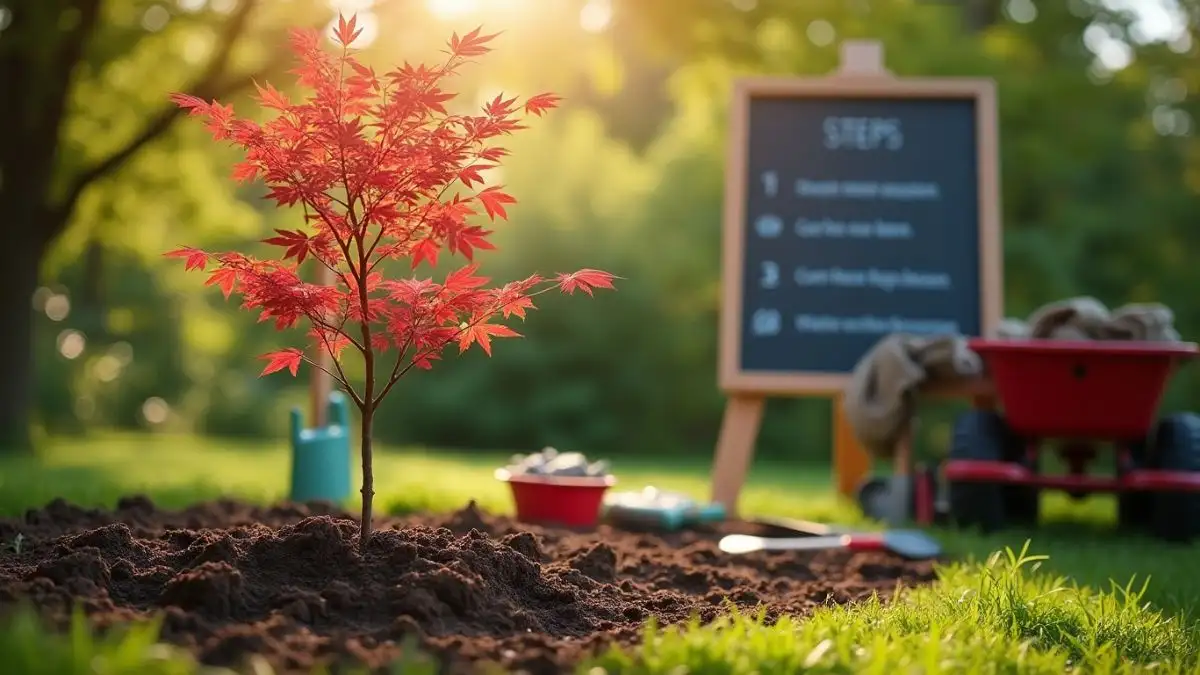Imagine stepping into your garden and being greeted by the vibrant, delicate leaves of a Japanese Maple tree, its colors shifting with the seasons. This stunning tree isn’t just a plant; it’s a living work of art that adds elegance and tranquility to any space. Whether you’re a seasoned gardener or a beginner, this guide will walk you through everything you need to know about planting Japanese Maple trees. From choosing the right variety to caring for your tree, we’ve got you covered. Let’s dive in!
Table of Contents
Understanding Japanese Maple Basics
Before you start planting Japanese Maple, it’s essential to understand the basics. Japanese Maples, scientifically known as Acer palmatum, are ornamental trees prized for their stunning foliage and graceful structure. They thrive in well-draining soil, prefer partial shade, and require moderate watering.
Key Requirements for Planting Japanese Maple
- Soil: Well-draining, slightly acidic soil is ideal.
- Sunlight: Partial shade (morning sun and afternoon shade) works best.
- Watering: Ensure the soil remains evenly moist at all times, but be careful not to overwater and cause waterlogging.
- Protection: Shield the tree from strong winds to prevent leaf damage.
If you reside in a colder region, there’s no need to fret! You can cultivate Japanese Maples by growing them in containers or offering winter protection.
Choosing the Right Japanese Maple Variety
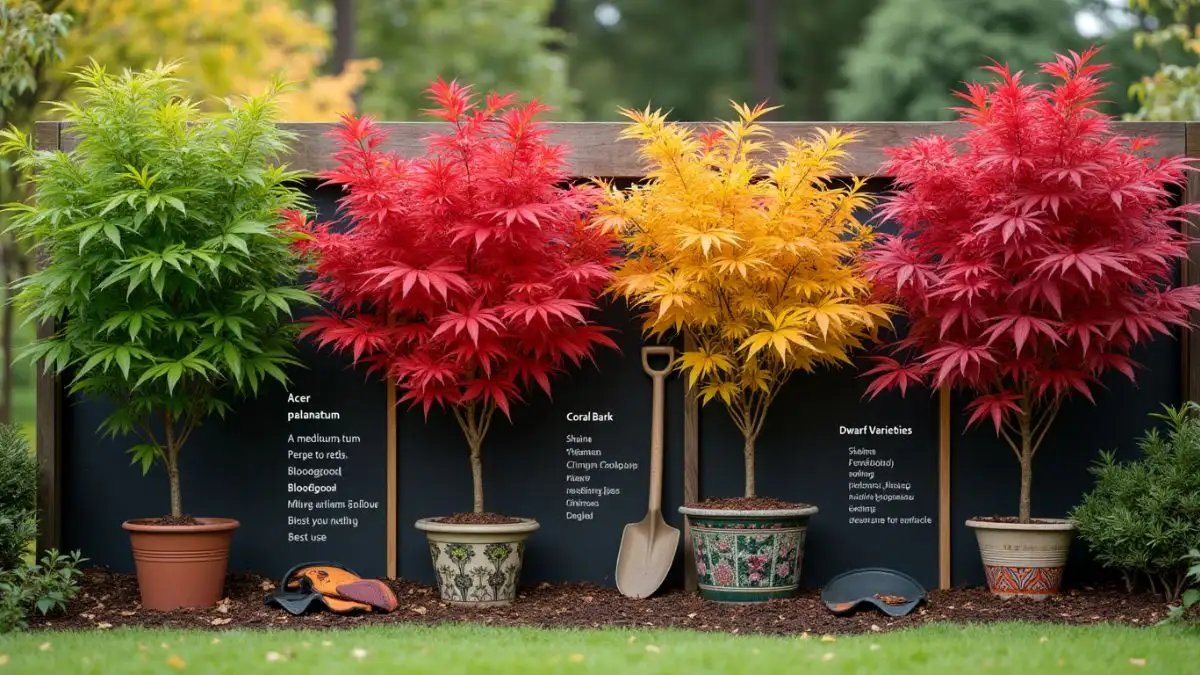
Not all Japanese Maples are the same. Some are better suited for small gardens, while others make stunning focal points in larger landscapes. Here’s a brief guide to assist you in selecting the appropriate variety for your requirements:
Popular Japanese Maple Varieties
| Variety | Foliage Color | Mature Size | Best Use |
| Acer palmatum | Green to Red | 15-25 feet | Ornamental |
| Bloodgood | Deep Red | 15-20 feet | Focal Point |
| Coral Bark | Red/Yellow Bark | 15-20 feet | Winter Interest |
| Dwarf Varieties | Various Colors | 6-8 feet | Container Planting |
For example, if you’re looking for a miniature Japanese Maple tree for a small garden or patio, a dwarf variety like ‘Shaina’ or ‘Crimson Queen’ is perfect. On the other hand, if you want a striking focal point, the Japanese red leaf maple tree variety ‘Bloodgood’ is an excellent choice.
Step-by-Step Guide to Planting Japanese Maple
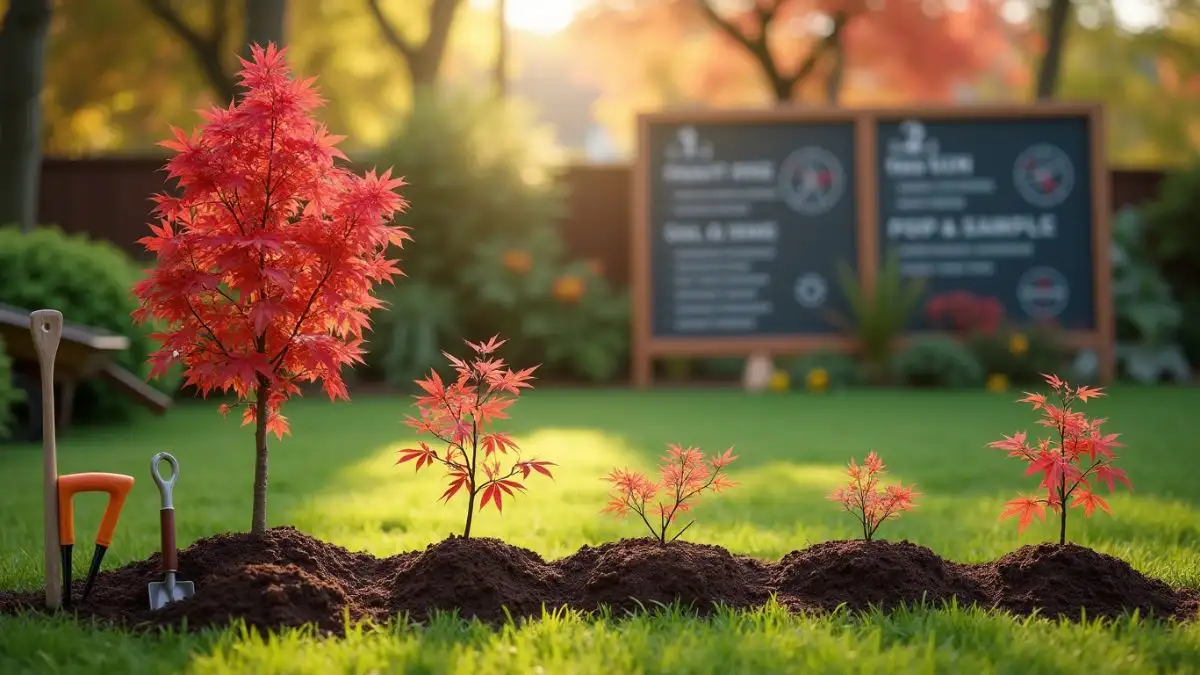
Now that you’ve chosen your variety, it’s time to get your hands dirty! Here’s a step-by-step guide to planting Japanese Maple:
1. Selecting the Location
Select a location with partial shade and shelter from strong winds. Japanese Maples flourish with morning sunlight and afternoon shade, particularly in warmer climates.
2. Preparing the Soil
Ensure the soil is well-draining and slightly acidic. If your soil is dense clay, enhance it with compost or organic material to boost drainage.
3. Digging the Hole
Dig a hole twice the width of the root ball and equal in depth. This provides ample space for the roots to expand and take hold.
4. Planting the Tree
Position the tree in the hole, making sure the root flare (the point where the roots connect to the trunk) is aligned with the soil surface. Be cautious not to plant it too deeply, as this can cause root rot.
5. Backfilling the Hole
Fill the hole with soil, lightly pressing it down to eliminate air pockets. Water deeply to assist the soil in settling.
6. Watering
Water the tree thoroughly post-planting to aid in root establishment. Maintain soil that is consistently moist but not overly saturated.
7. Mulching
Apply a 2-3 inch layer of mulch around the tree’s base to help retain moisture and stabilize soil temperature. Ensure the mulch is kept a few inches away from the trunk to avoid rot.
Caring for Your Japanese Maple Tree
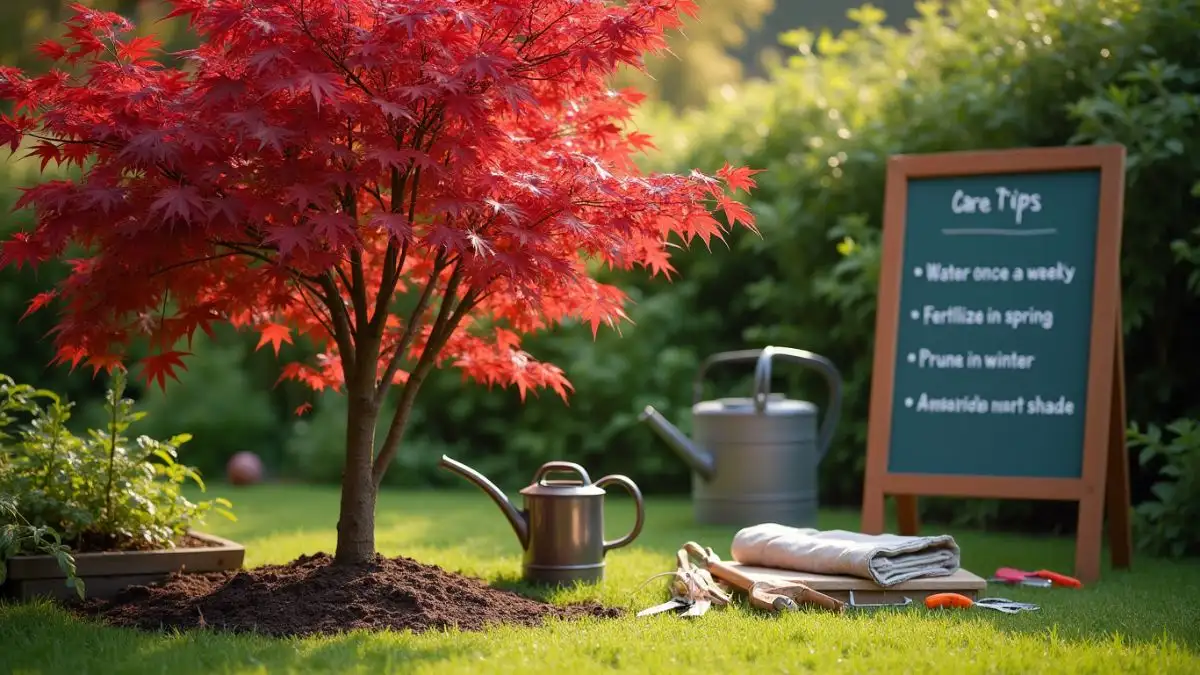
Once your Japanese Maple is planted, it’s time to focus on Japanese Maple care. Here are some essential tips to keep your tree healthy and thriving:
Watering
Japanese Maples prefer consistently moist soil. Water thoroughly once a week, particularly during dry periods. Be mindful not to overwater, as this can result in root rot.
Fertilizing
Use a balanced, slow-release fertilizer in early spring. Refrain from excessive fertilizing, as it can lead to rapid growth and weaken the tree.
Pruning
Prune your Japanese Maple in late winter to remove dead or crossing branches. Steer clear of extensive pruning, as it can put undue stress on the tree.
Sunlight
Japanese Maples thrive in partial shade. If cultivating a Japanese Maple in a container, position it in an area that receives morning sunlight and afternoon shade.
Common Problems and Solutions in Japanese Maple Care
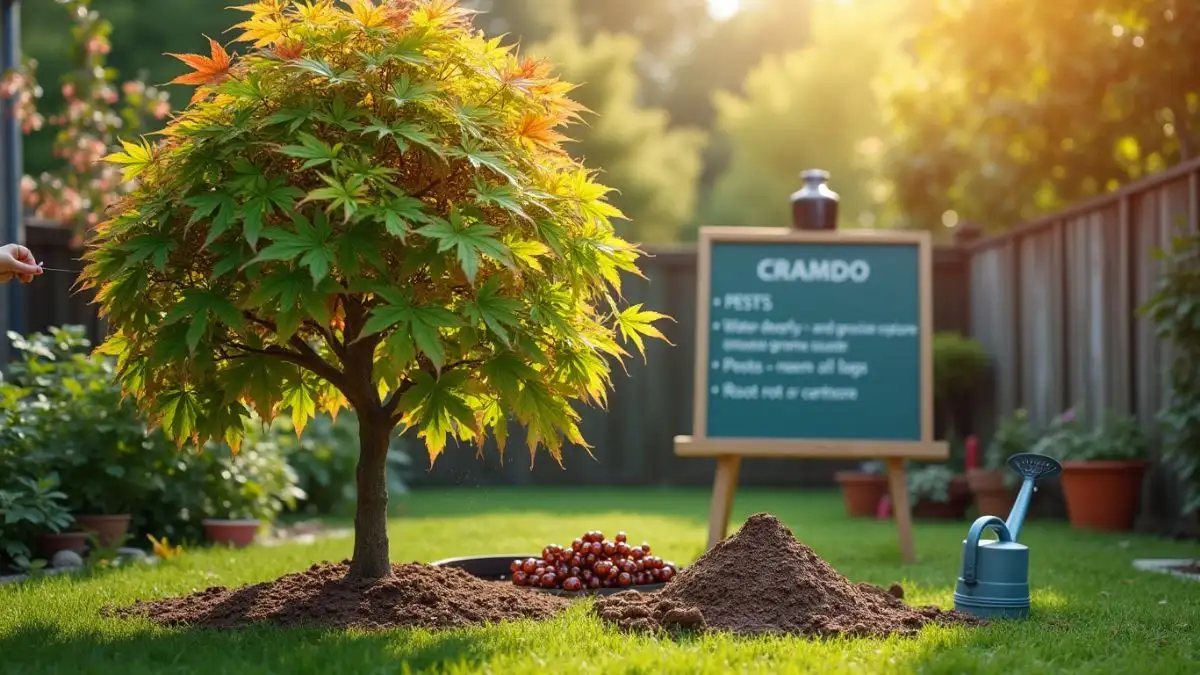
Despite providing excellent care, you could still face some challenges. Here’s how to troubleshoot common problems:
Leaf Scorch
Leaf scorch occurs when the tree loses too much water through its leaves. To avoid this, make sure to water sufficiently and offer afternoon shade.
Pests
Aphids and scale insects are common pests. Apply neem oil or bring in helpful insects such as ladybugs to manage them.
Root Rot
Root rot results from excessive watering or inadequate drainage. Make sure the soil drains well and prevent waterlogging.
Benefits of Planting Japanese Maple Trees

Why go through the trouble of planting Japanese Maple? Here are some compelling reasons:
Aesthetic Appeal
Japanese Maples are known for their stunning foliage, which changes color with the seasons. They bring sophistication and charm to any garden.
Environmental Benefits
Japanese Maples offer shade, enhance air quality, and establish a habitat for wildlife.
Therapeutic Benefits
Gardening with Japanese Maples can reduce stress and improve mental well-being.
Creative Uses for Japanese Maple Trees
Japanese Maples aren’t just for gardens! Here are some imaginative methods to integrate them into your landscape:
Garden Focal Point
Plant a Japanese red leaf maple tree as a centerpiece in your garden. Its vibrant foliage will draw the eye and create a stunning focal point.
Container Planting
Grow a miniature Japanese Maple tree in a pot for your patio or balcony. Dwarf varieties like ‘Shaina’ are perfect for small spaces.
Bonsai
Cultivate a Japanese Maple as a bonsai tree for indoor decor. This is a great way to enjoy the beauty of Japanese Maples year-round.
Conclusion: Start Your Japanese Maple Planting Journey Today
Planting Japanese Maple is more than just a gardening project—it’s an opportunity to bring beauty, tranquility, and a touch of elegance to your outdoor space. With their stunning foliage, graceful structure, and seasonal color changes, Japanese Maples are living works of art that can transform any garden into a serene retreat.
By following the 7 easy steps outlined in this guide, you’ll be well-equipped to grow and care for your own Japanese Maple tree. Whether you’re planting a Japanese red leaf maple tree as a focal point in your garden, growing a miniature Japanese Maple tree in a pot for your patio, or cultivating a bonsai for indoor decor, the possibilities are endless.
But the benefits of planting Japanese Maple go beyond aesthetics. These trees offer shade, enhance air quality, and establish a habitat for wildlife. Additionally, they provide therapeutic advantages, aiding in stress reduction and enhancing mental well-being. Plus, growing your own Japanese Maple is a cost-effective way to enjoy this stunning tree without breaking the bank.
So, what are you waiting for? Whether you’re a seasoned gardener or a beginner, now is the perfect time to start your Japanese Maple planting journey. Gather your tools, choose your favorite variety, and follow the steps in this guide. With a little patience and care, you’ll soon be rewarded with a thriving tree that adds beauty and tranquility to your garden for years to come.
Keep in mind that gardening is a journey, and each step you take moves you closer to success. Don’t be afraid to experiment, ask questions, and share your experiences with fellow gardeners. The satisfaction of cultivating your own Japanese Maple is unparalleled, and the benefits make the effort truly worthwhile.
Take the first step today. Your future self—and your garden—will thank you. Happy gardening!
FAQ Section
1. When is the ideal time to plant a Japanese Maple?
For optimal results, plant in early spring or fall.
2. Can Japanese Maples grow in full sun?
They thrive in partial shade, particularly in warmer climates.
3. How frequently should I water my Japanese Maple?
Water the plant once the top inch of soil has dried out.
4. What are the typical pests found in Japanese Maple trees?
Aphids and scale insects are common; use neem oil for control.
5. Can I grow a Japanese Maple in a pot?
Yes, choose a dwarf variety and ensure proper drainage.
6. How do I prevent leaf scorch in Japanese Maples?
Provide afternoon shade and ensure consistent watering.
7. What type of soil is best for Japanese Maples?
Well-draining, slightly acidic soil is ideal.
8. How tall do Japanese Maples grow?
Most varieties grow between 15-25 feet tall.
9. Can Japanese Maples be grown indoors?
Yes, as bonsai or in large containers with adequate light.
10. What are the benefits of planting a Japanese Maple?
They offer aesthetic beauty, shade, and therapeutic benefits.
By following this guide, you’ll not only master planting Japanese Maple but also enjoy the satisfaction of growing your own stunning tree. Happy gardening!


